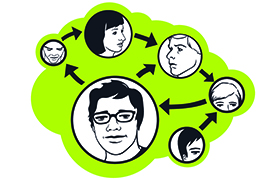When social media first gained attention, I heard many people scoff that these online connections couldn’t possibly be real friends. Some even used “Facebook friend” as a synonym for shallowness, fearing people might trade face-to-face interaction for a virtual life online.
But many years, re-tweets, meet-ups, event invitations and birthday wishes later, the majority of the people I know now consider at least some of their online friends to be extended family. Which made me wonder — does social media actually encourage people to connect IRL, or “in real life”?
A Pew Internet and American Life Project report recently found that Facebook users have more close relationships and receive more support than others. They’re also more likely to revive dormant relationships and use social networking to keep up with close social ties.
When online friends become real-life friends
One example of online translating into real-life interaction in a big way happened on Social Media Day, sponsored by Mashable on June 30. On that day, thousands of people attended more than 1,400 in-person meet-ups to celebrate the power of online connections. In Atlanta, attendance swelled well above the expected 413 RSVPs. The event included a contest in which the finalists in a drawing for an iPad learned on the spur of the moment they had to compete in an unexpected dance-off:
Connecting with Foursquare, Banjo
Then, there are location-based apps, like Foursquare, in which, say, if friends just checked in at the same store, restaurant or party, they might decide to seek each other out.
When veteran Damien Patton got home from a trip awhile back, he realized someone he served with in Operation Desert Storm had been at the same airport at the same time.
“I missed someone very important to me, and we hadn’t seen each other in years,” he said.
Saddened but inspired by the missed opportunity, he started a new company to help people use social media to connect face-to-face. He named it Banjo — partly because social media, like banjo music, can be fast and fun, but also because banjo players always seem to be surrounded by people attracted by the music.
The Banjo app reads geotags attached to people’s tweets, posts, photos, check-ins, etc. Users can then see who’s at the neighborhood hang-out, or living in a city they plan to visit. Here’s a video interview Patton did explaining Banjo to AllThingsD:
“There was an Apple engineer who designs for the iPhone in the coffee shop across the street,” Patton said. “I didn’t know who that person was, and it (Banjo) immediately had me down in the coffee shop and interviewing him for a position here.”
The morning we spoke, Patton said a potential investor who was in his office for a meeting opened Banjo and realized some people he needed to see were right down the street.
“Banjo is all about showing people what’s going on around them and then taking that into real life,” Patton said.
Quantity, yes, but what about quality?
Research shows that social media may also deepen what could otherwise be passing relationships. A study by Dr. Rey Junco of Lock Haven University found that college students who interacted with each other and their professors on Twitter were more likely to meet outside class to study; they also developed unexpected real-life connections. In one case, a popular athlete became friends with a quiet, comic book-loving classmate. Other students reached out to a stressed classmate who posted that he might harm himself.
The Twitter users Junco studied were also more likely than others to ask questions in class and less likely to leave school before their sophomore year.
“What I find most fascinating is that I’ve consistently seen that students who start a course being more introverted and not speaking up during class discussions become more extroverted and participate more when encouraged to communicate through social media with their professors and their classmates,” Junco said. (By the way, Junco discourages his student from tweeting during class.)
But if social media does increase the likelihood of real-life interaction, it can also sometimes complicate it. Stanford professor and author Jeremy Bailenson pointed out that when fans of social media meet face-to-face, their computers and mobile devices may actually make the meeting less productive; instead of looking at each other, they may be glued to their screens, multi-tasking.
“It’s hard to maintain focus when you have the virtual world at your fingertips,” Bailenson said.
Terri Thornton, a former investigative reporter and TV news producer, owns Thornton Communications, an award-winning PR and social media firm. She is also a freelance editor for Strategic Finance and Management Accounting Quarterly.

